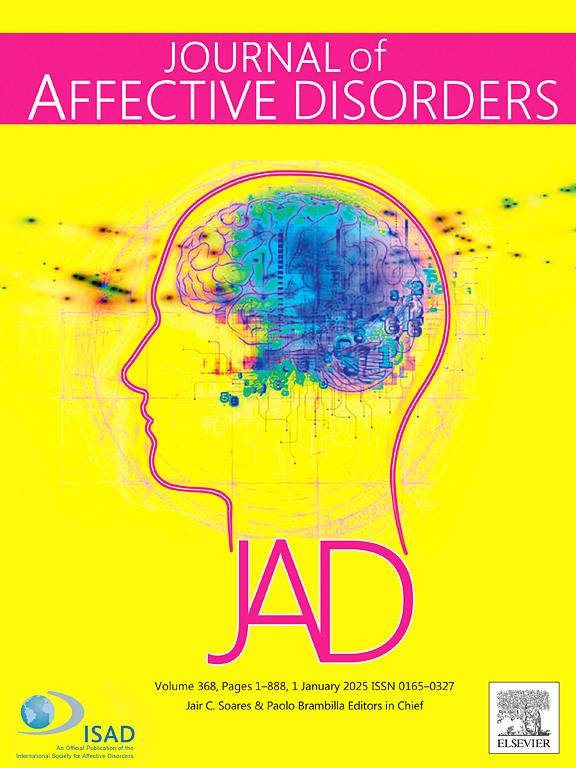一项评估前庭电刺激(VeNS)治疗重度抑郁症疗效的随机、双盲、假对照临床试验。
IF 4.9
2区 医学
Q1 CLINICAL NEUROLOGY
引用次数: 0
摘要
目的和目的:刺激前庭神经可能影响神经过程,如前额叶皮质功能,帮助认知灵活性和情绪调节,这是解决抑郁模式的重要方面。这项随机、双盲、假对照试验旨在确定非侵入性前庭神经电刺激(VeNS)装置治疗重度抑郁症(MDD)的有效性和安全性。材料与方法:62名成人(平均年龄43.1 = ±5.0 年)与MDD被随机分配接受积极ven设备(n = 31)或虚假的设备(n = 31)。两组患者每周5 天参加刺激课程(30 min)。主要结局是贝克抑郁量表(BDI-II)评分从基线到第8周的变化。次要结局是失眠严重指数(ISI)、广泛性焦虑障碍7项(GAD-7)和EQ-5D-5L健康效用指数(HUI)评分从基线到第8周的变化。干预后随访时间为第12周。结果:8 周后,活跃组的BDI-II平均评分比假手术组降低6.39分(P )。结论:当使用超过8周时,VeNS作为一种干预重度抑郁症的方法似乎具有临床意义的益处。本文章由计算机程序翻译,如有差异,请以英文原文为准。
A randomized, double-blind, sham controlled clinical trial to evaluate the efficacy of electrical vestibular stimulation (VeNS) for major depressive disorder
Aims and objectives
Stimulating the vestibular nerve may influence neurological processes such as prefrontal cortex functions, aiding cognitive flexibility and emotional regulation, important aspects of addressing depressive patterns. This randomized, double-blind, sham-controlled trial aimed to determine the efficacy and safety of a non-invasive electrical vestibular nerve stimulation (VeNS) device as a treatment for major depressive disorder (MDD).
Materials and methods
62 adults (mean age = 43.1 ± 5.0 years) with MDD were randomized to receive an active VeNS device (n = 31) or a sham device (n = 31). Both groups attended the clinic for stimulation sessions (30 min) 5 days per week. The primary outcome was change in Beck's Depression Inventory (BDI-II) score from baseline to week 8. Secondary outcomes were change in Insomnia Severity Index (ISI), Generalized Anxiety Disorder, 7-item (GAD-7), and the EQ-5D-5L Health Utility Index (HUI) scores from baseline to week 8. A post-intervention follow-up was at week 12.
Results
After 8 weeks, the active group showed a mean BDI-II score reduction of 6.39 points greater than the sham group (P < 0.001), with scores remaining low during the 4-week post-intervention follow-up. Additionally, the active group, compared with the sham group, showed a significant improvement in ISI (−6.29 vs. 2.23, p < 0.001), GAD-7 (−4.45 vs. -0.32, p < 0.001) and HUI (0.51 vs 0.11, p < 0.001) One minor Adverse Event was reported in the sham group. Formal blinding assessment demonstrated a successful level of blinding was achieved throughout the study.
Conclusion
VeNS, when delivered over 8-weeks, appears to have a clinically meaningful benefit as an intervention for major depressive disorder.
求助全文
通过发布文献求助,成功后即可免费获取论文全文。
去求助
来源期刊

Journal of affective disorders
医学-精神病学
CiteScore
10.90
自引率
6.10%
发文量
1319
审稿时长
9.3 weeks
期刊介绍:
The Journal of Affective Disorders publishes papers concerned with affective disorders in the widest sense: depression, mania, mood spectrum, emotions and personality, anxiety and stress. It is interdisciplinary and aims to bring together different approaches for a diverse readership. Top quality papers will be accepted dealing with any aspect of affective disorders, including neuroimaging, cognitive neurosciences, genetics, molecular biology, experimental and clinical neurosciences, pharmacology, neuroimmunoendocrinology, intervention and treatment trials.
 求助内容:
求助内容: 应助结果提醒方式:
应助结果提醒方式:


